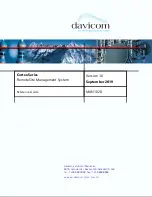
18
19
1.6 Exhaust
Do not operate the vacuum vented directly into the wall as it could cause damage to the
wall and/or vacuum. See Section 1.5 for adaptor instructions.
NOTE:
One elbow must be installed if the HEPA filter is not used (refer to Figure 5B).
1.8 System test/operation
Be certain to comply with local electrical codes and regulations. Plug the unit into an electrical outlet.
You are now ready to check the vacuum installation:
• Be sure the dirt bucket is properly secured to the vacuum.
• Plug the hose into each inlet valve and turn on the central vacuum system with the power button on the handle
ensuring the electrical contacts operate properly.
• The central vacuum system can also be turned on/tested by pressing the power button on the power unit.
• Check each inlet valve for air leaks.
• Check each pipe connection for air leaks.
WARNING!
Do not use extension cords or outlets with inadequate current carrying capacity. Connect the power cord to a dedicated
branch circuit. Before hanging the power unit on the wall, install the HEPA filter supplied with the unit.
1.7 Bag adaptor
The bag adaptor is easy to install prior to placing the central vacuum unit on the wall with the dirt bucket removed. The bag
adaptor has three unique ends, each connecting to a specific component.
1. Using the two Torx 20 screws, secure end “A” to the intake flange on the back inside body of the central vacuum unit
(refer to Figure 6A).
2. Secure end “B” to the Quick Clean Valve from the inside of the central vacuum unit by aligning and locking the tabs
into place (refer to Figure 6B).
3. Push the cardboard collar from the filter bag on to the open hanging end “C” of the bag adaptor (refer to Figure 6C).
4. Reconnect the dirt bucket to the central vacuum unit and ensure the filter bag is completely sealed in both the central
vacuum unit and dirt bucket.
Figure
Figure 5B
6A
6B
6C
If the HEPA filter are not utilized and the power unit is exhausted to
the outside.
QCLEAN_CD_2014_Manual_.indd 18
2014-04-30 16:31






































